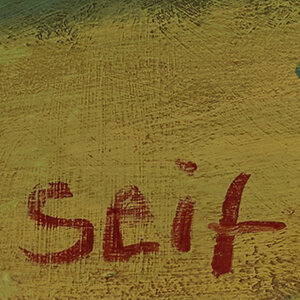


Last updated on Sun 12 October, 2008


Nostalgia
Al Masar Gallery │Contemporary Art
October 12 – October 30 2008
Egypt has always been a fertile breeding ground for Modern and Contemporary Art. The great Modern Egyptian Art movement launched owning to the founding of the first Art School in 1908, by Prince Youssef Kamal. The school flourished the insight of art and thus the understating of the Modern Art in Egypt.
Nostalgia– Late Artists of the 1st and 2nd Generation- Can proudly present a great collection of remarkable masterpieces by the foremost Artists of the Art’s movement.
Among these, paintings of Egypt’s popular life and Coptic Monks by Ragheb Ayad (1892-1978), Impressionist paintings by Youssef Kamel, Drawings by Abdel Hadi Al-Gazzar (1925-1966), Paintings by Seif and Adham Wanly, paintings by Saiid Al Adawy, and last but not least, paintings by the “Egyptian Rouault” Mahmoud Mohamed Afifi, and others who had a big role in defining the art scene in Egypt.
The Beginning
The Egyptian Art Movement
The Plastic Arts are Egypt’s most significant and magnificent additions to human heritage over the age of its great civilization.
Thus, Ancient Egypt presented throughout thousands of years its masterpieces in architecture, sculpture, photography and other art work.
The contribution of art sustained throughout the Christian era due to that the Coptic art was the most noteworthy left by this civilization.
The Islamic Egyptian impart on the Islamic art distinguished personality, which was revealed in the architectural work of art, which embraced other arts and presented them in a magnificent unit, as revealed in all form of art, from pottery to clothes and from the beautification gear to sculptures on wood, metal, and marble.
Egypt endured an epoch in which it lost its distinguished qualities which were obliterated by the invaders, although its artistic creation was still sparkling through the folklore and traditional professions.
Then Egypt hosted a further aspect of life by the entrance of Bonaparte’s army, whose military crusade was accompanied by a crowd of scientists and artists, including archaeologists, musicians, photographers and poets.
The aim of Bonaparte was to unveil the facade of this legendary country, this extraordinary host settled at one of the ancient Egyptian districts. The artists dwelled in “Bet El-Semary” in an alley still bearing the name of the scientist “Monge;” The assistant of the great scientist La Foisier, one of the scientific – cultural campaign leaders.
Through the effort of the French campaign photographers, Egypt knew another aspect and style of artistic expression opposing in its logic and manner Egypt’s plastic art conception, especially in its Islamic aspect:
It seems that the Egyptians were fascinated by life simulating pictures, as El-Gabarty referred to them in his Journals, and how he dazzled by their being true to life and simulation of nature.
Some of the French campaign photographers captured some of Al-Azhar Sheiks. These were shortly transported to the museum of Versailles palace.
Soon after, followed by the arrival of artists to Egypt, photographing its natural scenes, its neighborhoods of oriental fragrance academically, though it was touched by the spark of the impressionism movement and what followed of change by some artists like Fermentan, Paul Le Noir, Theodore Frere and Emil Bernard.
In this epoch, Egypt took the first steps towards revival and along it came the awakening of awareness on the hands of a number of intellectuals and writers, who were educated in Egypt and migrated to Europe where they realized the art’s position in the western society. Hence, they returned hauling the desire for more concentration and promotion of art.
Pioneers Generation
This climate prepared a convenient opportunity for fine tutorship arts to take its position in our lives side by side with modern sciences in Egypt.
This idea was achieved on the hand of some foreign artists who dwelled in Egypt and turned El-Kharunfush neighborhood into an art district similar to those of Paris.
Not far from this neighborhood, the first school for fine arts was opened in Cairo in May 1908. This school was sponsored by a French sculpture, an Italian photographer and two other French artists; one of which architecture and the other for decorative art. These were two among several artists who were fond of Egypt and hence decided to stay for a time period.
Upon the opening of the school, a huge number of youths amounted to 400 students was enrolled.
Those students were a cocktail of youths coming from the countryside or those who left their studies at El-Azhar University, to practice this new fascination; fine arts. Residing among them were also a number of expatriates as well as a group of Egyptian students who made a fine progress in the modern education.
Along with this minority, an extraordinary student existed; Ragheb Hanna Ayyad, who received his first education at Frères School, witnessed in El-Kharunfush neighborhood the foreign artists’ studios as well as turning it in the beginning of the twentieth century into a center of their enthusiastically artistic activity. This is how the student Ragheb Hanna Ayad knocked the doors of the arts school, equipped with a conception about its mission.
Education in the Egyptian School was organized in a manner similar to Bonaparte’s School in Paris and Italy. The method of education was Greek as well as Roman; however the instructors of the school, who were familiar with Egypt, took their students out of the studios and brought them into Cairo’s different neighborhoods en route for witnessing actuality.
Join us in our endless discovery of modern and contemporary Arab art